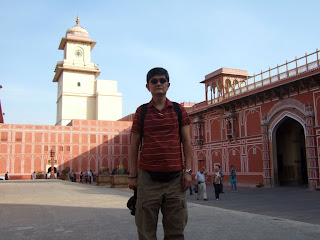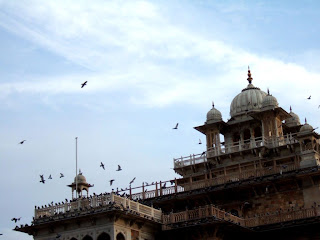
Jaipur is the capital of Indian northern State of Rajasthan and the first planned city in India. It situated on a semi-desert land with a population of 6 million, and is well known for its colorful culture, forts and palaces. In the era of 16th century when most Rajputs were busy fighting with each other, Jaipur's rulers diplomatically widened their control sphere by maintaining good relations with Mughals and increase great wealth for the kingdom. In view of the increase in population and shortage of water at the original capital, Amber, The ruler, Maharaja Sawai Jai Singh II decided to build a new city and started the construction of fortification walls along with the seven strong gates, roads, squares and major palaces in 1727. The new city, Jaipur was named after him. Jaipur is one of the most attractive destination in tourism of India and also one of the best educational ground for many Indians. It has 8 universities and more than 100 over colleges and institutes in engineering, medical and management.
The most magnificent monuments at town is Hawa Mahal, Palace of the Wings. It located near Badi Chaupad Square, right at the center of the bustling Johari Bazaar. The enormous tapering structure with numerous arches, spires and a mind-boggling 953 latticed casements and small windows was built of red sandstone. It has 5 floors in which, 3 are rooms and the lower 2 are places to connect to rooms and courtyards. It was believed that this magical airy building was built by Sawai Pratap Singh in 1799 as a view gallery for royal ladies to watch the on-going or parades or procession below while remaining hidden themselves. The carved big screen facing the main street is the back portion of the building.


City Palace situated in the heart of Jaipur city, is a structure of historical importance and a great souvenir of the regal past. This palace complex starting outer wall construction between 1729-1732, initiated by Maharaja Sawai Jai Singh II, ruler of Amber at that time while other buildings were completed by successive rulers towards 20th century. It is the major landmark and famous tourists attraction in Jaipur.


City Palace covers a huge area into series of gardens, courtyards and a group of unique and arresting complex of several palaces, pavilions, and temples.


City palace is a symbol of magnificence in the fusion architecture of Indian+ Mughals+ European.




Sabha Niwas is the memorial hall of the King and photography was prohibited . The marble floor chamber known as Diwan-I-Khas was an audience hall of Maharajas. There were two 340 kg x 400 litre x 1.6 m high huge sterling silver vessels at both sides, which are the largest in the world. These two Ganga Water holding urns were made from 14,000 metled silver coins without soldering. It was made by Maharaja Sawai Madho Singh II who was a highly pious Hindus, to carry Ganga River water to drink on his trip to England to attend Edward VII's coronation in 1901.



Chandra Mahal is one of the magnificent buildings in the complex. It has 7 storey and each storey was specified by different names, with beautiful floral decorations and paintings. Part of the buildings are still residence of the descendants from former rulers of Jaipur and ground floor house a museum and opened to public, displaying manuscripts, carpets, manuscripts, paintings of the royal family.


Ridhi Sidhi Pol adorned with themes of 4 seasons are 4 small gates to enter into the palace. Peacock gate at the entrance represented Autumn, rose gate with repeated flower pattern represented Winter and green gate with waves represented spring while lotus gate with flower and petal pattern represented summer.




The auspicious palace of Mubarak Mahal was built by Maharaja Madho Singh II as a reception center to the guests . It consisted a fusion architecture of Islamic + Rajput + European style


Mubarak Mahal palace now becomes a costume gallery, displaying royal attires, sarees, and block prints of fine textiles.


The entrance, the window and gold gilded doors.




The two entire different architectural design of the two structures. (1) Hawa Mahal, Palace of the Wings for royal ladies and (2) Mubarak Mahal Palace for outside guests.


Jantar Mantar is one of largest and most remarkable observatories built by Sawai Jai Singh. who was then a lover of astronomy



This open air observatory indicated a high peak of medieval Indian astronomy.


Most of the instruments including altitudes gauges, times calculating eclipses, were made from stone ad marble to achieve its accuracy.



A precisely and scientifically designed collection of complex astronomical observatories and instruments including of a 27m high sundial.



The half celestial sphere rim was invented by Maharaja Sawai Jai Singh to represent horizon for finding the positions of all heavenly bodies.



Each of these unique sculptures has a specific purpose such as measuring the position of stars etc. and continually provides a fairly accurate information to this day.


Outside these beautifully decorated walls of Open Air Observatory site, is a large area of very poor and disorder slum where groups of beggars, old or young, man or woman spreading out their palms begging from visitors.



Central Museum is also called as Albert Hall, named after the consort of Queen Victoria's husband, Albert.


It lies in Ram Niwas Garden, which was built in 1868 by Maharaja Sawai Ram Singh II as a relief project for his famine struck subjects.



The foundation was laid by the son of Albert, Prince of Wales in 1876 and modeled on the Victoria and Albert Museum of London. It was a fine example of Indo-Saracenic style architecture.


The museum displays a rich collections of paintings, carpets, ivory, stone, metal sculptures, pottery, woodwork and costume of that period.



Great number of pigeons in the vast and verdant garden in front of Central Museum.


Modern government building was among the traditional structures and surrounded by ancient wall.



The distinctive red appearance of avenues and buildings in Jaipur city.


The pink color was used at the time of making to create an impression of red sandstone buildings of Mughai cities.





The whole city was painted in pink to welcome Prince of Wales when he visited Jaipur in 1853 during the regime of Sawai Ram Singh.



Almost all existing buildings were converted to commercial stalls.


The elegant structure of Palace of the Wind was along this bustling and busy street of Jaipur old town center.



Fortification walls at dusk


Jai Mahal is the summer lake palace built for royal duck shooting parties. It is amidst the Man Sagar Lake.



Elephant ride was one of the major transportation inside the walled city.



Street procession to celebrate religious function are common at Jaipur.



A sea of yellow along the highway between Jaipur and delhi. India is one of the rape seed oil producer in the world.


Attracting by such a beautiful scene, we stopped and had some pictures with our local driver.



Young women at rape seed flower farm, harvesting the flowers to processing into edible oil.



Vast area of rape seed flower farms and also herbs plant along the highway between Jaipur and Delhi



All kinds of vehicles, mechanical or animal driven carts are allowed to use the highways, very fair!.



This was the Indian made 2000 cc heavy duty Tata sedan car we used to crossing the golden triangle of India. Indian Oil is their national oil company.


All commercial and long distances vehicles are magnificently decorated. They honk throughout the highways or streets as if their traffic rules are based on honking only.




Miles of heavy vehicles lined up at states boundary, waiting to settle the interstate taxation when crossing the borders. Drivers were requested to stop the vehicle, and walk to the office to pay the levy implemented by each and individual state. All are done manually.


No comments:
Post a Comment